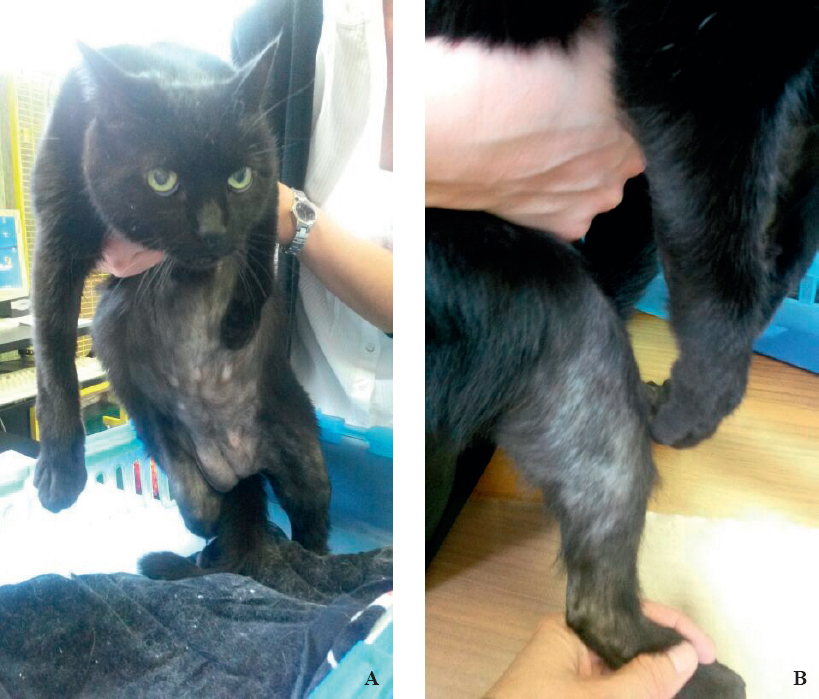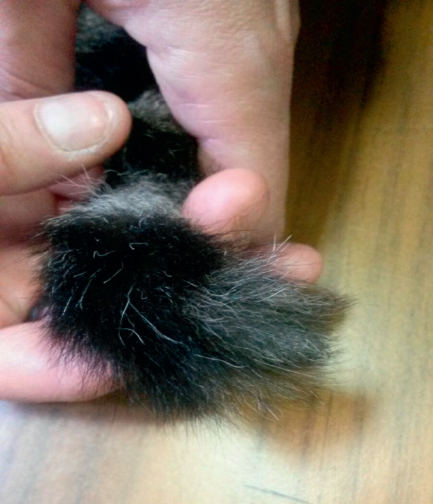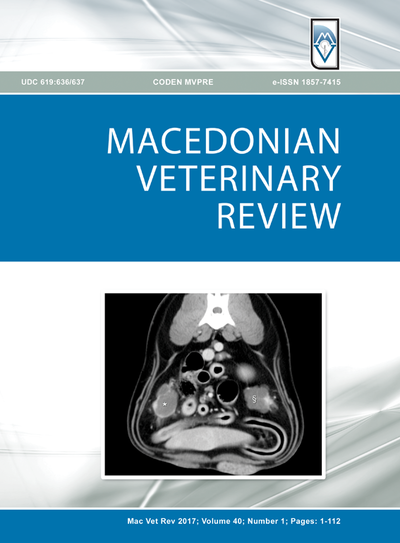INTRODUCTION
Compulsive disorders are repetitive, stereotypic motor, locomotor, grooming, ingestive, or hallucinogenic behaviours that are usually brought on by conflict and occur out of context to their “normal” occurrence or in a frequency or duration that is in excess of that required to accomplish the ostensible goal (1, 2). As the condition progresses, the behaviours are manifested in a manner that interferes with the animal’s ability otherwise to function in the animal’s social environment (2).
In feline patients, compulsive behaviours include feline psychogenic alopecia or feline psychogenic dermatitis that is described as a self-inflicted skin disorder that results from excessive grooming, chewing, and/or hair-pulling, when underlying medical causes have been ruled out. The patients usually present with alopecia of the medial thighs, abdomen, tail, and, or dorsal lumbar areas (3, 4) (Fig. 1A, B).
Figure 1 A, B. Common areas of excessive grooming in cats suffering from psychogenic alopecia
Cats can exhibit self-trauma behaviours in situations of conflict, frustration, or when their behavioural needs are not addressed (4). A geographic alteration, a sudden change in companionship, access to the outdoors, various medical conditions and physiological states, may initiate or provoke inappropriate grooming behaviour. Cats may then use coping mechanisms such as grooming in response to these situations (3). Neuroendocrine reward mechanisms released during grooming may reinforce and maintain the behavioural pattern, leading to self-inflicted alopecia (5).
CLINICAL CASE
A 5-year-old neutered male domestic short-hair cat was presented to behavioural consultation for evaluation of alopecia of distal tail resulting from a sudden onset of excessive self-grooming that manifested as licking and excessive hair-pulling.
The cat started licking his tail excessively few months before the behavioural consultation. At that time, because of the severity of the self-induced injuries caused in only a few days, the veterinarian decided to intervene immediately with a surgical partial caudectomy, without performing any further diagnostic tests. An Elizabethan collar was placed on the cat for 2 weeks resulting in the wound healing. The pathological behaviour recurred 3 months after surgery.
The cat was seen at another veterinary clinic, where it was subjected to dermatologic evaluation. The physical examination revealed an area of noninflammatory hair loss on the distal extremity of the tail. No abnormalities were seen on the trichogram, fungal culture and skin scraping. Flea bite hypersensitivity, cutaneous adverse food reaction and atopic dermatitis were excluded by exams and elimination diet. Because these tests were negative, a trial treatment with a glucocorticoid was set to differentiate pruritus from behavioural self-trauma (5, 6); ten days of steroid therapy were ineffective and excluded cat pruritus. The owner declined histological examination of skin biopsy samples obtained from the lesion.
The cat was referred for a neurological examination that did not reveal specific pathologies. The radiographic examination of tail and lumbosacral spine and urine, haematological and blood chemistry tests showed no abnormalities. The patient did not show any pain or pruritus in response to palpation or manipulation of the tail.
Because of the absence of a diagnosis, the cat was referred for a behavioural consultation. During the behavioural visit, information was collected about the onset of the disorder, the home environment, the interaction with the owners, the temperament and behaviours of the cat (drinking, feeding, exploratory, elimination, play, predatory, grooming, sleep, sexual and aggression).
Alterations were noted in cat’s temperament and in grooming, exploratory, play and predatory behaviours. At home, the cat was generally anxious and fearful. His home environment was poor, with no toys and high or hiding places. Interactions with the owners were limited and irregular. The examination of the animal confirmed the alopecia of the distal portion of the tail (Fig. 2). The behavioural consultation highlighted possible psychogenic alopecia resulting from generalized anxiety and fear.
Figure 2. Alopecia of the distal portion of the tail caused by excessive grooming. The cat did not have tail bandaging and Elizabethan collar from 1 day
The cat was treated with clomipramine for 2 months at a dose of 0.5 mg/kg/PO SID. Behaviour modifications, such as a counterconditioning and desensitization procedures, consistent and positive owner responses and avoidance of any discipline or punishment, were prescribed. Factors that could contribute to anxiety were identified, treated, and his environment was made predictable and sufficiently enriched. The clinical symptoms were resolved after 1 month of behavioural and environmental modification and drug therapy. After discontinuation of drug therapy, the cat was monitored for a period of six months. During this time, owners reported minimal licking and no hair pulling. The patient was much calmer and more tolerant, and his usual anxious behaviour was reduced.
DISCUSSION
One of the most frustrating problems in feline clinical medicine is determining whether a cat presented for evaluation of self-mutilation and over-grooming has a behaviour problem or an underlying medical issue.
In the presented clinical case, before reaching the correct diagnosis of psychogenic alopecia, the animal underwent surgery that did not prevent the recurrence of the disorder. When veterinarians examine a cat with a self-directed behaviour, all possible underlying causes should always be considered. In fact, because of the heterogeneous and potentially multifactorial origins of self-directed behaviours, the clinical evaluation should include a thorough general, dermatologic, and neurologic exam and appropriate laboratory testing (7, 8).
Involving a behaviourist for a behavioural evaluation will also be extremely useful in such cases. The behavioural examination may include information about the animal’s life history and management, assessment of the animal’s disposition or temperament, and focus on the compulsive behaviour itself (9).
In pets, compulsive behaviours are considered to be a consequence of stress, frustration or conflict (4, 9). In an anxious cat like that of the current clinical case, some factors, such as poor home environment and limited and irregular interactions with the owners, could have triggered the self-directed behaviour. In fact, while locomotory compulsive disorders tend to develop after repeated conflict, oral self-directed behaviours may develop more acutely, without identifiable initial conflict, and are most likely to be displayed in situations of minimal (or even insufficient) stimulation, sometimes helping the pet to better cope or settle (10, 11).
To resolve the disorder, environmental changes, behaviour modifications and pharmacological therapy were prescribed. Because psychogenic alopecia derives from conflict behavior, the cause of conflict, frustration, and stress should be removed (10). Pets that develop compulsive disorders may be particularly sensitive to inconsistency or lack of predictability in their daily schedule or in their interactions with their owners (11). A more predictable daily routine and sufficiently enriched environment should be considered the first line of therapy in the treatment of cat’s compulsive disorders (3, 11). Environmental enrichment for cats may provide opportunities for mental and physical stimulation, serve as a form of distraction from potentially provocative stimuli, and offer some degree of control over their physical and social environment (7).
The daily program should include a regular routine of social interaction with owners. Consistent and positive owner responses and avoidance of any discipline or punishment should further reduce any anxiety. Casual and inconsistent owner interactions should be replaced by a “learn to earn” program where the owners give rewards only to shape desirable responses (4). Desensitization to stress-inducing situations can be done by teaching a new behaviour that is incompatible with the stereotypic behaviour (12). The owner should learn to predict when the undesirable behaviour is likely to arise so that alternate acceptable activities can be scheduled and reinforced as a substitution for the unacceptable behaviour (7, 11). Furthermore, potential stressors in the cat’s environment must be eliminated for psychogenic alopecia to be resolved (3).
Although the pathophysiology of compulsive disorders is not entirely understood, an underlying alteration in neurotransmitters is a likely factor and pharmacologic intervention is often needed. Abnormal serotonin transmission seems to be the primary mechanism by which stereotypies are induced (13).
Clomipramine, a serotonin reuptake inhibitor, has proven to be effective in the treatment of psychogenic alopecia (5, 10, 14). For the treatment of compulsive disorders a therapy of six weeks or longer may be necessary to evaluate any clinical improvement. Medication should be continued for at least 1 month after the clinical signs disappeare, while behaviour modification should be continued (11, 14).
CONCLUSION
The case report highlights the difficulty of an accurate diagnosis and the importance of differential diagnosis when cats are presented for a veterinary visit for excessive licking and hair-pulling. To involve different veterinary specialists is important to reach the appropriate therapy for disorders that may have multiple underlying causes. A multi-specialist consultation would probably have helped avoid the cat surgery. In the case report, clomipramine was effective in controlling the signs of anxiety-related and obsessive-compulsive disorders in combination with behaviour modification.
Psychogenic alopecia is a diagnosis of exclusion and requires a complex diagnostic workup. The clinical evaluation should consist of a thorough clinical examination, including general, dermatological, neurological, and laboratory tests. Once overt medical causes have been ruled out, a diagnosis of psychogenic alopecia is based on behavioural examination.
CONFLICT OF INTEREST STATEMENT
The authors declared that they have no potential conflict of interest with respect to the authorship and/or publication of this article.








